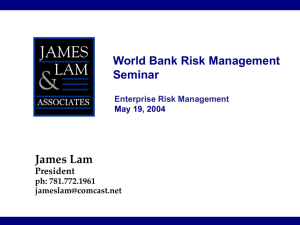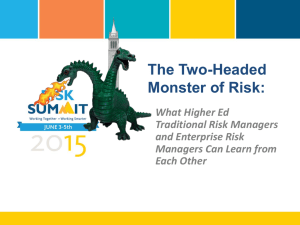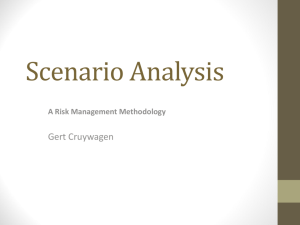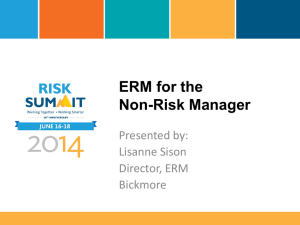James Lam The OSU Risk Institute Launch ERM and Business Strategy
advertisement
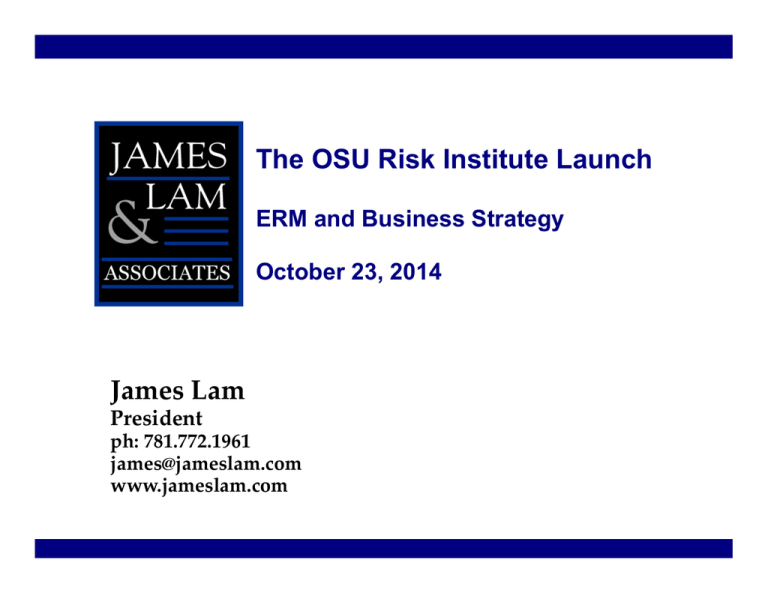
The OSU Risk Institute Launch ERM and Business Strategy October 23, 2014 James Lam President ph: 781.772.1961 james@jameslam.com www.jameslam.com Filename Key take-aways for today 1. Risks we face are highly complex and interdependent 2. Integrated enterprise risk management (ERM) can add significant value 3. We must address four fundamental questions for managing risk 4. Continuous ERM, including strategic risk management, represents the next frontier 1 Key risks we face as a business Strategic/Business Risk – Do we have the right business model and strategy? Are we executing against that strategy effectively? Are we pricing for the cost of risk in our products and services? Financial Risk – What is our exposure to market prices (i.e., interest rates, FX, equity prices, energy prices)? What is our exposure to borrowers and counterparties who may fail to perform on their contractual obligations? Can we raise cash to meet our obligations in cost effective and timely manner? Operational Risk – What is our exposure to failures in people, processes, systems, and external events? For example, are we protected against cyber-security risks? Legal/Compliance Risk – Are we in compliance with laws and regulations? Are we prepared for proposed laws and regulations? Reputational Risk – What is the potential economic impact due to perceptions of our key stakeholders, including customers, employees, shareholders, regulators, and the general public? 2 ERM is useful because the risks faced by companies are highly interdependent Enterprise-Wide Risks Financial Risks Event-driven financial risks Financial Risk Strategic Risk IT alignment with business strategy Operational Risk Documentation of financial contracts Credit Risk Associated with Investments Market Risk Liquidity Risk Funding Liquidity Asset Liquidity Credit Risk Credit Risk Associated with Borrowers and Counterparties 3 ERM requires balancing the hard and soft side of risk management Hard Side Soft Side Measures and reporting Risk awareness Risk oversight committees People Policies & procedures Skills Risk assessments Integrity Risk limits Incentives Audit processes Culture & values Systems Trust & communication 4 Case study: Background 2-Year ERM Program New capital markets business Established risk policies and systems Traders hired from foreign bank Instilled risk culture Aggressive business and growth targets Captured 25% market share with zero policy violations Survived “Kidder” disaster Recognized as best practice 5 Early adopters of ERM have reported significant and tangible benefits Benefit Company Actual Results Market value improvement Top money center bank Outperformed S&P 500 banks by 58% Early warning of risks Large investment bank Global risk limits cut by 1/3 prior to Russian crisis Loss reduction Top asset management company Loss-to-revenue ratio declined by 30% Regulatory capital relief Large commercial bank $1 billion regulatory capital relief Insurance cost reduction Large manufacturing company 20-25% reduction in insurance premium 6 Benefits of Effective Governance and ERM McKinsey and Company (2002). Institutional investors in North America willing to pay an premium of 12-14% for effective corporate governance Gompers, Ishii, and Metrick (2003). Investment strategy of buying firms with strong shareholder rights and shorting firms with weak shareholder rights produced excess return of 8.5% Cremers and Nair (2003). Firms with strong governance mechanisms produced excess annualized returns of 8% Brown and Caylor (2004). Firms with effective governance produce higher ROE, higher profit margin, and greater dividend payout Cheng and Wu (2005). Top decile companies in the ISS Corporate Governance Quotient ratings produced higher ROAs, higher ROEs, and higher P/E ratios Hoyt and Liebenberg (2009). ERM use among public US insurers was associated with an equity price premium of 16.5% Standard & Poor’s (2010). North American and Bermudan insurers with “excellent ERM” had better stock performance in 2008 (-30% vs. -60%) and 2009 (+10% vs. -10%) when compared to those with “weak ERM” 7 ERM Framework and Processes Governance Structure and Policies Who? How? (ex-post) Dashboard Reporting and Monitoring Enterprise Risk Management Risk Assessment And Quantification How? (ex-ante) Risk Management What? 8 The “three lines of defense” for ERM 3rd Line of Defense Board of Directors (and Audit) • Establish board risk governance and oversight processes • Approve risk policies; link strategy, risk, and compensation • Accountable for periodic review and assurance of controls 2rd Line of Defense CRO and ERM Function (and Corporate Management) • Establish and implement risk and compliance programs • Execute risk policies and standards, risk appetite & tolerances, and reporting processes • Accountable for ongoing risk monitoring and oversight 1st Line of Defense Business Units (and Operating Functions) • Assume risk to generate profits and growth • Execute customer management, product pricing, P&L plans • Ultimately accountable for business/risk management 9 Value drivers Risk Management Impact Revenue Expenses ROE Losses 1. Risk-based pricing 2. Target customer selection 3. Relationship management 4. Risk oversight costs 5. Insurance/hedging expense 6. Credit and market losses Shareholder Value Equity New Business 7. Capital management 8. Risk transparency 9. New business development Growth M&A Risk Management by Silos (5, 6) Financial risk management (4–7) 10. M&A/Diversification strategy Enterprise risk management (1-10) 10 Risk-adjusted pricing Required Net Income Required Net Income = Cost Economic of X Capital Capital + Tax + Expense + Risk Losses = Required Net Revenue 11 Measuring profitability and pricing Calculate ROE Calculate Pricing Exposure $100 mm $100 mm Margin 2.50% 2.20% Revenue $2.5 mm $2.2 mm Risk Losses <0.5 mm> <0.5 mm> Expense <1.0 mm> <1.0 mm> $1.0 mm $0.7 mm <0.4 mm> <0.3 mm> Net Income $0.6 mm $0.4 mm Economic Capital $2.0 mm $2.0 mm RAROC 30% 20% Pre-Tax Net Income Tax 12 Adverse selection Will lose competitors who use risk-adjusted price Risk-Adjusted Price Price Non-RiskAdjusted Price AAA AA A Risk Rating Will win business from competitors but earn below hurdle rate return BBB 13 WSJ Article: Airbus Officials Cite Challenges Key Takeaways Hans Peter Ring, Airbus CFO, said: “[Airbus] must now do a better job of putting a price tag on the risks inherent in their airplane programs.” “We are in a high-tech, complex business, and there is a lot of risk in our business. That won’t change. The question is how to price risk. Obviously, in some cases we didn’t price it right.” Posted over €2 billion charges for two big programs – A380 superjumbo (maximum luxury, e.g., showers and private suites, vs. production problems) and A440M military plane (fixed price contract vs. immature technology) Boeing also faced significant delays and cost overruns with its 787 (efficient production among large number of suppliers vs. complex outsourcing issues) Source: WSJ, June 10, 2010 14 Between 1982 and 2003, 76 companies within the S&P 500 experienced a 30% or more relative value decline in one month Industry Mix Energy • Halliburton Co. • Transocean Inc. Energy 5% Financials 9% Financials • Capital One • Providian • U.S. Bancorp Utilities • AES Corp • Dynegy Inc. • Williams Cos. Materials • Allegheny • Sealed Air Corp. Materials 4% Industrials 13% Industrials • Lockheed Martin • Tyco International • Waste Mgmt. Telecom 5% Utilities 17% Health Care • Baxter Int’l • Lily(Eli) & Co. • United Health Consumer Products 21% Health Care 26% Telecom • Nextel Comm. • Qwest Comm. • Sprint Corp. Consumer Prod. • Mattel Inc. • NIKE Inc. • Clear Channel 15 Strategic 61% co g e ct Pr ic l in g &A es re su su Is es M d Le ga De m an Pr er od u iv Pr t it un t in m pe ns um Number of events 20 I rr eg C o u la r s t it ie Ov s er D ru M eb an t P ns ag ro em bl em en tI s Su s u p p es ly Ch ai Co n m m Fo od re ity F o ig n Pr Ex re ic ig ch es n a M ng ac e ro Ra -E te co In n t e om re s t ic Ra te s Ac Co Co Strategic and operational risks were major factors, and 33 out of 76 have not recovered by the end of the period 25 STRATEGIC 61% 15 OPERATIONAL 30% 10 FINANCIAL 9% 5 0 Operational 30% Financial 9% 16 Strategic risk identified as the major cause for financial distress Organization Research Methodology Key Findings James Lam & Associates (2004) S&P 500 (1982-2003) One-month stock price decline of 30% or greater relative to the S&P 500 61% were exposed to strategic risks 30% were exposed to operational risks 9% were exposed to financial risks The Corporate Executive Board (2005) Fortune 1000 companies (1998-2002) Top 20% of companies with the greatest market value declines Deloitte Research (2005) 65% were exposed to strategic risks 20% were exposed to operational risks 15% were exposed to financial risks Among the 100 largest declines: Thomson Financial Global 66 involved strategic risks 1000 Companies (1994 62 involved external events 2003) 61 involved operational risks One-month stock price decline relative to the Morgan 37 involved financial risks Stanley Financial World Index 17 Integrating Strategy and Risk Management Performance Integrating Strategy and ERM Distribution of Outcomes 1. Define business strategy and objectives [or functional performance targets] 2. Establish KPIs based on expected performance 3. Identify risks that can drive variability in performance (risk assessments) Worst Case Performance Expected Performance 4. Establish KRIs for critical risks 5. Provide integrated monitoring with respect to 1-4 18 ERM 2.0 Vision: Shaping continuous risk management practices 1. ERM is a robust and continuous management process, with its overall performance tracked in a feedback loop 2. In partnership with Finance, ERM supports the organization’s strategy and strategy execution processes 3. Data and analytics are interconnected from ERM, audit, compliance, and other key functions 4. A collaborative reporting system enables integrated analysis and reporting, including role-based dashboard reporting 5. ERM is fully integrated into board, corporate management, and business line decision-making 19 An ERM dashboard should address five key questions for senior management 1. Are any of our business objectives at risk? 2. Are we in compliance with policies and regulations? 3. What risk incidents have been escalated? 4. What KRIs and trends require immediate attention? 5. What risk assessments need to be reviewed? 20 One of the most critical questions facing risk professionals today “How do you know if your risk management program is working effectively?” 21 Establishing a feedback loop on ERM Earnings-at-Risk Analysis Worst Case EPS = ($1.00) 1. 2. 3. 4. 5. Expected EPS = $3.00 Business Plan: Interest Rates: Oil Price: Key Initiatives: Expense Control: $2.00 $1.00 $0.50 $0.30 $0.20 $4.00 Earnings Attribution Analysis Expected EPS : Actual EPS: Difference: $3.00 $1.00 $2.00 Business Plan: Interest Rates: Key Initiatives: Unforeseen Factors: $1.00 $0.50 $0.10 $0.40 $2.00 Key Questions: 1. Did we identify the key risk factors? 2. Were our EPS sensitivity analyses accurate? 3. Did risk management impact our risk/return positively? 22
